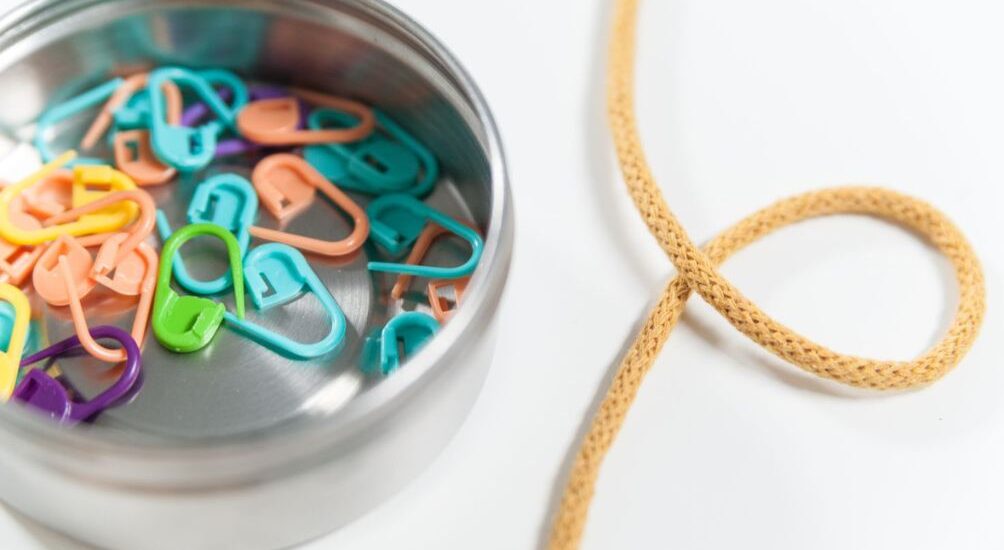Stitch markers are small, often overlooked tools that play a significant role in the world of knitting and crocheting. Whether you’re a beginner or an experienced crafter, stitch markers can help streamline your projects, enhance your precision, and even add a bit of fun to your crafting experience. In this comprehensive guide, we’ll delve into the various types of stitch markers, their uses, and how to choose the right ones for your needs.
What Are Stitch Markers?
Stitch markers are small devices used to mark specific points in your knitting or crochet work. They can be used to mark the beginning of a round, the location of a particular stitch pattern, or the point where a specific technique needs to be applied. Available in a wide variety of shapes, sizes, and materials, stitch markers are essential for keeping track of complex patterns and ensuring your work remains accurate.
Types of Stitch Markers
- Locking Stitch Markers
Locking stitch markers resemble small safety pins and can be easily opened and closed. These are particularly useful for crochet projects, where you might need to insert and remove markers frequently. - Ring Stitch Markers
Ring stitch markers are simple, closed loops that you slide onto your knitting needle. They are perfect for marking specific points in knitting projects, such as the beginning of a round or a pattern repeat. - Split Ring Stitch Markers
Similar to ring stitch markers but with a small gap, split ring markers can be easily slipped onto your work without the need for opening and closing. They are versatile and can be used for both knitting and crochet. - Clip-On Stitch Markers
Clip-on stitch markers, often resembling small clothespins, can be attached to the fabric of your project. These markers are handy for marking rows or specific points within a row. - Earring-Style Stitch Markers
Earring-style markers have a small hook, similar to an earring, which can be easily inserted into your work. They are often decorative and can add a bit of flair to your knitting or crocheting. - Row Counter Stitch Markers
These markers not only mark your stitches but also help keep track of the number of rows you’ve completed. They are particularly useful for projects with repeated patterns.
How to Use Stitch Markers
Marking the Beginning of a Round
When knitting in the round, it’s easy to lose track of where the round starts and ends. Placing a stitch marker at the beginning of the round helps you keep track of your progress and ensures that your work remains consistent.
Indicating Pattern Repeats
Complex patterns often involve repeated sequences of stitches. By placing stitch markers at the beginning and end of each repeat, you can easily follow the pattern and avoid mistakes.
Marking Increases and Decreases
When working on a project that requires increases or decreases, stitch markers can help you remember where these changes need to be made. This is particularly useful for shaping garments or accessories.
Keeping Track of Stitch Counts
For large projects, keeping track of the number of stitches can be challenging. Placing a marker every ten or twenty stitches can help you quickly count your work without having to start from the beginning each time.
Choosing the Right Stitch Markers
Material
Stitch markers come in various materials, including plastic, metal, and rubber. Choose a material that suits your project and personal preference. Metal markers are durable and smooth, while plastic markers are lightweight and often more affordable.
Size
Ensure that your stitch markers are the right size for your needles or crochet hooks. Markers that are too small can get lost in your work, while those that are too large can interfere with your stitches.
Shape
The shape of the stitch marker can also affect your work. Smooth, round markers are less likely to snag on your yarn, while those with decorative elements can add a touch of personalization to your project.
Visibility
Choose stitch markers in colors that contrast with your yarn. This makes them easier to spot and ensures that you don’t accidentally knit them into your project.
Creative Uses for Stitch Markers
Beyond their practical applications, stitch markers can also be used creatively. Some knitters and crocheters enjoy making their own stitch markers using beads, charms, and other decorative elements. This adds a personal touch to their crafting tools and can make the process even more enjoyable.
Caring for Your Stitch Markers
To ensure your stitch markers last as long as possible, take good care of them. Keep them organized in a small container or pouch to prevent them from getting lost. Clean them occasionally to remove any dirt or residue, especially if they are made of metal.
Stitch markers may be small, but they are mighty tools that can greatly enhance your knitting and crocheting experience. By understanding the different types of stitch markers and how to use them effectively, you can tackle even the most complex projects with confidence. So, the next time you sit down with your yarn and needles or hook, don’t forget to have your trusty stitch markers by your side. Happy crafting!
For high-quality stitch markers and other essential knitting and crocheting supplies, check out Stokits. As an Authorized Wholesaler & Distributor in the USA, Stokits offers a wide range of art supplies, including yoga equipment, kitchen equipment, cotton pads, and buds. Contact us at sales@stokits.com for more information.





